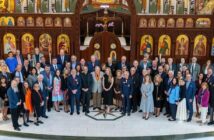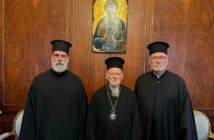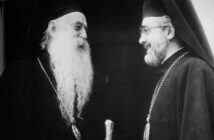Source: Public Orthodoxy
by Matthew Namee | български | ქართული | ελληνικά | Română | Русский | Српски
One of the keystone prerogatives claimed by the Ecumenical Patriarchate is its jurisdiction over the so-called “diaspora”—regions not included within the geographic boundaries of the other Autocephalous Churches. She insists that this exclusive extraterritorial jurisdiction is rooted in Canon 28 of Chalcedon which states:
[O]nly the metropolitans of the Pontian, Asian, and Thracian dioceses, as well as the bishops of the aforementioned dioceses among barbarians are ordained by the aforementioned most holy throne of the most Holy Church of Constantinople.
This phrase—“the bishops of the aforementioned dioceses among barbarians”—is interpreted by supporters of the EP’s claims to refer to “those territories beyond the geographical boundaries of the other Local (autocephalous) Churches.”
But that’s not what the canon explicitly says; it’s an interpretation. On its face, the canon seems to refer only to bishops who belong to the dioceses of Pontus, Asia, and Thrace, who are ministering among certain barbarians. The standard canonical commentators—Zonaras, Balsamon, Aristenos—all interpret the phrase literally, referring to specific barbarian groups who were adjacent to Pontus, Asia, and Thrace. At the turn of the 19th century, St Nikodemos repeats this interpretation in the Pedalion. The modern theory is nowhere to be found.
The modern theory seems to have its origins at the turn of the 20th century, as the empires of old gave way to nation-states, and when a large Greek diaspora emerged in the Americas. For Greek Orthodoxy, America was a wild west, with de facto independent parishes loosely connected to one or another Old World hierarchy. Eventually, the EP decided that something must be done. In 1907, a Patriarchal commission suggested that all Orthodox churches in the “diaspora” should fall under the EP’s jurisdiction. Ecumenical Patriarch Joachim disagreed, proposing instead that the Greeks in America report to the Church of Greece, while the other diaspora churches (mostly Russian) continue remain under their current authorities.
In March 1908, the EP issued a Tomos clearly setting forth the “barbarian lands” theory as the basis for the Patriarchate’s jurisdiction in the diaspora, while at the same time focusing specifically on ethnic Greeks, not all Orthodox Christians. The Tomos begins by asserting that the Holy Synod is attempting to find, in the ancient canons, a basis for dealing with a specific pastoral challenge that has arisen. The Tomos then asserts the barbarian lands theory:
… it was abundantly manifest that neither was the Most Holy Church of Greece … nor was another Church or Throne able to presume, by its own authority, to canonically reach beyond the boundaries of its own region, except for our Most Holy, Apostolic, and Patriarchal Ecumenical Throne, both from the prerogative granted to It to ordain the bishops in the barbarian lands and those declared beyond defined ecclesiastical regions, as well as of Itself by the intercessions, properly justified to exercise supreme spiritual protection for said churches on foreign [soil].
The Patriarchate then cedes to the Church of Greece “the right of oversight of all Greek Orthodox Churches in the diaspora.”
Initially, we have a very expansive canonical claim: the reference to Constantinople’s right “to ordain the bishops in the barbarian lands” is a clear invocation of Canon 28, and the Tomos asserts that only Constantinople can “canonically reach beyond the boundaries of its own region.” But the Tomos is clearly focused on the Greeks, not Orthodox people in general. It’s not that the Tomos concedes those non-Greeks to other Orthodox Churches; it’s that the Tomos doesn’t mention non-Greek Orthodox people at all.
* * *
In 1921, the exiled, erstwhile Metropolitan of Athens, Meletios Metaxakis, oversaw the creation of the Greek Archdiocese of North and South America. At the time, the canonical position of Meletios and the Archdiocese was ambiguous, but by the end of the year, Meletios was suddenly elected Ecumenical Patriarch. He was enthroned in February 1922, and one of his first acts as Patriarch, on March 1, was to revoke the 1908 Tomos and reestablish the Patriarchate’s authority in the diaspora.
This revocation was done via a Praxis issued by Meletios and his Holy Synod. This is the first place I’m aware of where a fully expansive “barbarian lands” theory is set forth, with no limitation to ethnic Greeks. The Praxis describes the 1908 Tomos as having granted to the Church of Greece the Patriarchate’s “canonical right of supreme power and protection over Greek Orthodox Communities in the Diaspora and which were outside the established boundaries of the Most Holy Orthodox Autocephalous Churches.” The Praxis specifies that these communities were “Greek-speaking.” And because the Church of Greece had failed to successfully organize these communities, Constantinople was taking back its power over the diaspora, “by Her inviolable right to manage and conduct by Her own authority the canonical authority belonging to Her from the sacred canons and the Ecclesiastical order, in which is included the ecclesiastical supervision of those outside and in the diaspora of Orthodox Communities.” So the Praxis jumps from a focus on Greek-speaking people to all Orthodox communities, of any ethnicity or language. To remove any doubt as to the expansiveness of this claim, the Praxis reaches its crescendo in its penultimate paragraph:
She reinstates immediately complete and intact Her ruling canonical rights, and immediate supervision and governance—without exception—of all Orthodox Communities found outside the boundaries of each of the Autocephalous Churches, whether in Europe, or America, or anywhere else; bringing them immediately under the immediate Ecclesiastical dependence and guidance, and determines those that arise thereafter will belong only to Her and from Her possess the validity of their Ecclesiastical formation and actuality.
Then, on May 17, Meletios and his Holy Synod issued a Tomos establishing the Archdiocese of North and South America as an eparchy of the Ecumenical Patriarchate. This May Tomos begins by reiterating the “barbarian lands” theory: “The canonical ordinances and the centuries-old practice of the Church ascribe the Orthodox communities which are found to be outside the canonical boundaries of the individual Holy Churches of God under the pastoral governance of the Most Holy, Apostolic, Patriarchal, Ecumenical Throne.”
Unlike the 1908 Tomos, which begins with an expansive claim of territorial jurisdiction, but then shifts to focus only on the Hellenic diaspora, and unlike the earlier March 1922 Praxis that revoked the 1908 Tomos, the 1922 Tomos makes no reference at all to ethnicity. The Tomos decrees that “from now on all Orthodox communities found in North and South America, and whatever Orthodox ecclesiastical bodies which exist now, or henceforth shall be founded, are to be known as members of one body, namely, the ‘Orthodox Archdiocese of North and South America.’” Not “Greek Archdiocese,” but “Orthodox Archdiocese.”
The Praxis seems to envision the Archdiocese as being the sole canonical body for all Orthodox Christians in North and South America. However, the Archdiocese has never had the pan-Orthodox character that seemed to be implied by the Tomos. The original Charter of the Archdiocese, also issued in 1922, refers to it as the Greek Archdiocese, and it is designed for those Orthodox Christians who use Greek as their liturgical language. The Charter specifies that the Archdiocese exists to organize the spiritual life of Greeks and of Orthodox Americans of Greek origin.
* * *
These two acts by Meletios and his Synod were just a part of a flurry of activity by the Ecumenical Patriarchate. In March, the same month the 1908 Tomos was rescinded, Meletios spent a week negotiating with a Serbian Orthodox delegation about the autocephaly of the Serbian Church. Another tomos created the Metropolis of Thyateira and Great Britain to oversee parishes in Central and Western Europe. The Tomos on North and South America came in May; in September, Meletios issued a letter on the validity of Anglican orders.
Meletios’s election and all this activity I just described took place during a period of stalemate in the Greco-Turkish War, a tension-filled lull before the Asia Minor Catastrophe. In February and March, when Meletios was enthroned and when he rescinded the 1908 Tomos, the Allies, led by Britain, held diplomatic meetings in London, trying to broker an armistice. Ataturk wasn’t having it, and the Greeks were increasingly demoralized and divided. In the weeks leading up to the Tomos on the diaspora, the Soviet government—which, for its part, was busy persecuting the Russian Orthodox Church—sent large sums of money to aid Turkey. The Greeks began to fixate on Constantinople. Everyone was going for broke.
This is the context in which Meletios and his Synod rescinded the 1908 Tomos and established the Archdiocese of North and South America. The future of the Ecumenical Patriarchate, of Orthodoxy in not only Turkey but in Russia and, frankly, everywhere else, was suddenly in doubt. The great empires that had defined the Orthodox world for centuries—Russian, Ottoman, Habsburg—were suddenly gone, and in their place was uncertainty at best, and in many cases persecution and destruction. In this context, Meletios, perhaps the most creative, ambitious, and politically-minded Patriarch in history, dramatically reinvented the very institution of the Ecumenical Patriarchate, recasting its purpose as the master of an expansive “barbarian lands” that covered the majority of the globe.
Matthew Namee is the editor of Orthodox History, where he’s blogged since 2009.
A longer version of this paper was originally presented at the conference “The Greek Archdiocese at 100 Years,” Hellenic College-Holy Cross Greek Orthodox School of Theology, October 7, 2022. The full text of the original paper, along with footnotes and links to the 1908 and 1922 documents (Greek originals and English translations), is available at https://orthodoxhistory.org/2022/10/12/the-origins-of-the-barbarian-lands-theory/.
Public Orthodoxy seeks to promote conversation by providing a forum for diverse perspectives on contemporary issues related to Orthodox Christianity. The positions expressed in this essay are solely the author’s and do not necessarily represent the views of the editors or the Orthodox Christian Studies Center.





5 Comments
What is the thesis statement for this essay?
When the Muslims took over Jerusalem, Alexandria, Antioch and other territories, these bishops and Patriarchs turned to Constantinople as an overseer. The Bishop (Patriarch of Jerusalem) is Greek, not Arab. From this, Constantinople began to think of itself as the “Center of Orthodoxy.” Canon 28 only refers to “barbarian lands” surrounding the Black Sea close to Constantinople. As more & more Greek people left Greece & Asia Minor, Constantinople wanted to keep its reign on these people through the church. Therefore, all Greek churches had to be under Constantinople even though Orthodox Canon Law states otherwise. Canon 28 became Constantinople’s excuse for usurping such authority. Russia, not to be outdone, began doing the same and thus the mess we have today. The Canons are clear: Each territory is to have its own autocephalous church to administer to its own churches. Foreign churches establishing dioceses outside their own territory is just uncanonical. We don’t see Istanbul, Russia (Moscow) or others running to correct this!
Nikolai:
“The Canons are clear. Each territory is to have its own autocephalous church to administer its own churches. Foreign churches establishing dioceses outside their own territory is just uncanonical.”
It sounds good. Actually, better than good, it also makes sense. I believe you, but it would help if you cite the canons you are referring to.
The fact that all of the autocephalous churches agreed to authorize the establishment of Assemblies of Bishops around the world (including one for us here in America) and tasked them to come up with plans to bring the church in their territories “into canonical order” certainly implies that they know that having 14 overlapping ethnic jurisdictions, all but one of which are under synods that are outside of the territory of the US, is “uncanonical.”
Since it appears that Istanbul and Moscow don’t want to correct this, the clergy and laity have to convince the AOB to do what the OCL’s Declaration asks them to do.
Mr. Kacazes,
This is my last post for 2022, at least. I don’t want to bore everyone to death. Hopefully, the year 2023 will be the year we have one autocephalous Orthdox Church in America. America sorely needs our witness, and we need to speak as one voice. No more captivity, foreign bishops, and patriarchs interfering in our internal affairs. No more waste and duplication of vital resources. No more division because of our inability to have autocephalous Orthodox Church in America. “Unless the Lord build this house, our labor is in vain.” Well, that’s it for me. Merry Christmas during this Christmas season which begins when Nativity lent has ended. Christ is born- Glorify Him!! Let’s do it, and thank you for your leadership, Mr. Kacazes, in this vital matter. The Lord will repay you.
Peter,
Thank you. Christ is born! Glorify Him!
All the blessings of our Lord for you and your loved ones this Christmas and New Year.
Our bishops serving in America need to hear our prayers and voices. They must understand that unity and autocephaly are what they are called upon to bring to Orthodoxy in this land. It will strengthen world Orthodoxy, especially the Mother Churches.
Unity will empower our bishops to do God’s will without fear or the permission of synods in territories located on the other side of the world…an altogether different hemisphere.
I pray that in 2023, all those who have added their names to the Declaration will reach out to everyone on their contact lists and encourage them to add their names and that each of those do likewise until the numbers cannot be ignored by the Assembly of Bishops.